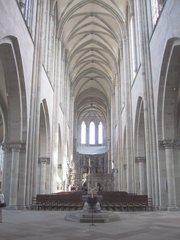Magdeburg
|
|

| Contents |
History
Magdeburg was one of the most important medieval cities of Germany. Emperor Otto I lived during most of his reign in the town and was buried in the cathedral after his death. Important dates in the town's history include:
- 805 First recorded mention in the Diedenhof Capitulary as Magadoburg. Although settlement on the site had existed for centuries, the first mention of Magdeburg occurred during the reign of the emperor Charlemagne, when he secured the small fishing and trading town.
- 919 King Henry I the Fowler fortified Magdeburg against the Magyars and Slavs.
- 929 Henry I arranged with king Edward the Elder for Edward's daughter Edith (Editha, Eadgyth) to marry Otto I, son of Henry. At Otto and Edith's wedding she received Magdeburg as a Morgengabe - a Germanic customary gift received by the new bride from the groom and his family after the wedding night.
- 937 A royal assembly took place in Magdeburg. At the same time, the abbey of Saint Maurice, later the cathedral, was founded.
- 946 Queen Edith died and was buried in the abbey church crypt.
- 968 At the Synod of Ravenna, Magdeburg became elevated to the status of archbishopric and Adalbert received consecration as its first Archbishop.
- 973 Emperor Otto I dies and is buried in the cathedral of Magdeburg.
- 1035 Magdeburg received a patent giving the city the right to hold trade exibits and conventions, the basis of the later family of city laws known as Magdeburg rights. Many visitors from many countries trade in Magdeburg.
- 13th century Magdeburg becomes a member of the Hanseatic League
- 1524 Martin Luther is called to Magdeburg, where he preaches and causes the city's defection from Catholicism. In the following years Magdeburg gains a reputation as a stronghold of Protestantism and it becomes the first major city to publish the writings of Martin Luther. The emperor outlaws the unruly town.
- 1631 During the Thirty Years' War imperial troops storm the city and commit a massacre, killing about 20,000 inhabitants and burning the town in the sack of Magdeburg. After the war only a population of 400 remains in the totally destroyed town.
- 1654 Otto von Guericke makes the Magdeburg hemispheres, two hollow shells with rings for attaching ropes, puts them together with grease, and evacuates the air with a pump that he had invented some years before. Sixteen horses fail to pull the hemispheres apart.
- 1680 Brandenburg annexes Magdeburg, which thus loses its status as an Imperial Free City.
- 1815 After the Napoleonic Wars Prussia sets up the province of the Prussian Province of Saxony, with Magdeburg as its capital.
- 1945 During World War II Magdeburg (350.000 inhabitants) suffered near total destruction from Allied firebombing. The very impressive Gründerzeit suburbs north of the city, called the Nordfront, were destroyed. It was the second most devastated city in Germany -only Dresden suffered more. American and Soviet troops occupied the city; however, the Americans soon left, leaving the city under Soviet stewardship.
- 1945-1990 In the postwar years, most of the remaining city buildings were destroyed, with only a few buildings near the Cathedral restored to their pre-war state. Prior to Reunification, many surviving Gründerzeit buildings are left unhabited and, after years of degradation, are waiting for demolition. Few remain to testify of a once proud, culturally rich city.
- 1990 Magdeburg becomes the capital of the new state of Saxony-Anhalt within reunified Germany. The city center is rebuilt almost exclusively in a modern style, rejecting Madgeburg's millennia spanning history.
Cathedral of Magdeburg
- Main article : Cathedral of Magdeburg
Magdeburg's most impressive building, the cathedral of Saints Catherine and Maurice, has a height of 104 m. -- the highest church building of eastern Germany.
The predecessor of the cathedral was a church built in 937 within an abbey, called St. Maurice. Emperor Otto I was buried here beside his wife in 973. St. Maurice burnt to ashes in 1207. The exact location of that church remained unknown for a long time. The foundations were rediscovered in May 2003, revealing a building 80 m long and 41 m wide.
The construction of the new church lasted 300 years. The cathedral of Saints Catherine and Maurice was the first Gothic church building of Germany. The completion of the steeples took place only in 1520.
While the cathedral was virtually the only building to survive the massacres of the Thirty Years' War, it nevertheless suffered destruction in World War II. But it was soon rebuilt and completed in 1955.
The place in front of the cathedral (sometimes called "new marketplace", Neuer Markt) was occupied by an imperial palace (Kaiserpfalz), which was destroyed in the fire of 1207. The stones of the ruin served for building the cathedral. The presumptive remains of the palace were excavated in the 1960s.
Other sights
Monastery_Unser_Lieben_Frauen_Magdeburg.jpg
- Monastery "Unser Lieben Frauen" (literally "Our Beloved Lady"), 11th century, containing the church of St. Mary.
- Town hall (1698); a town hall has stood on the marketplace since the 13th century, but it was destroyed in the Thirty Years' War; the new town hall was built in a Renaissance style influenced by Dutch architecture.
- Landtag; the seat of the government of Saxony-Anhalt is a Baroque palace built in 1724.
- Monuments: the city has monuments depicting emperor Otto I (old marketplace, 1240) and Otto von Guericke (1907).
Related articles
External links
- Official Magdeburg homepage (English) (http://www.magdeburg.de/english/index.html)
- IKUS - the intercultural Students of Magdeburg (English/German) (http://www.unikus.de/)
- Satellite photo from April, 2005 (http://archive.spaceimaging.com/ikonos/2/kpms/2005/04//browse.7927.crss_sat.0.0.jpg)bg:Магдебург
da:Magdeburg de:Magdeburg es:Magdeburgo eo:Magdeburgo fa:ماگدبورگ fr:Magdebourg it:Magdeburgo nl:Maagdenburg nds:Meideborch ja:マクデブルク no:Magdeburg pl:Magdeburg pt:Magdeburgo sv:Magdeburg

